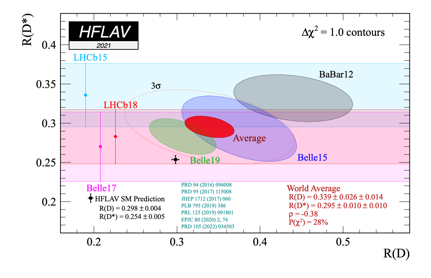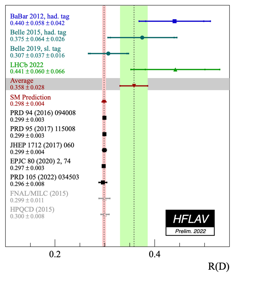[ R(D*) = 0.281±0.018±0.024 ]
[ R(D) = 0.441±0.060±0.066 ]
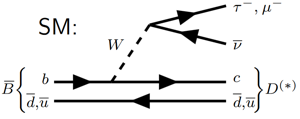
Today at the CERN seminar the LHCb Collaboration presented new tests of lepton universality, one of the basic principles of the Standard Model (SM) of particle physics. This principle states that the SM treats the three charged leptons (electrons, muons and taus) identically, except for kinematical effects due to their different masses. In this analysis LHCb physicists compared the beauty particle decays into D0 or D* charmed mesons together with τ or μ leptons and their corresponding neutrinos. The image shows the SM Feynman graph representing these decays. The measured observables are the ratios of branching fractions R(D*) = ß(B→D*τ–ντ) / ß(B→D*μ–νμ) and R(D) = ß(B–→D0τ–ντ) / ß(B–→D0μ–νμ). These ratios are particularly interesting since a large class of SM extensions contain new interactions which involve the third generation of quarks and leptons, such as here a b quark (from a B hadron) and τ– and ντ leptons. In particular, the presence of additional charged Higgs bosons, which are often required in these models, can have a large effect.
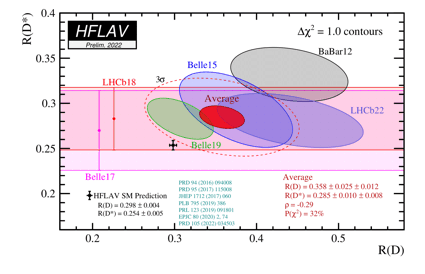
Yesterday’s world status of R(D) and R(D*) measurements, compiled by the HFLAV collaboration, is shown in the image above to the left. As the τ lepton is much heavier than the muon this leads to a SM prediction for R(D) and R(D*) substantially smaller than unity. The e+e– collider experiments BaBar and BELLE measured both R(D) and R(D*) observables and their results are presented as ellipses in the two dimensional plot. The LHCb collaboration previously measured only the value of R(D*) and therefore the LHCb results are marked as points with error bars and represented as horizontal bands. The world average is indicated by the red ellipse and differs by 3.3 standard deviations (σ) from the SM prediction marked as a black point with error bars. Today’s LHCb R(D) and R(D*) measurements (“LHCb22”) are included in the image above to the right as well as in the new world average. The deviation of the world average (red ellipse) with respect to the SM calculations is now 3.2 σ similarly to the previous one. The LHCb R(D) and R(D*) measured values, listed at the top of this news, are compatible both with the current world average and with the SM. The result agree with the SM prediction based on lepton universality within two standard deviations.
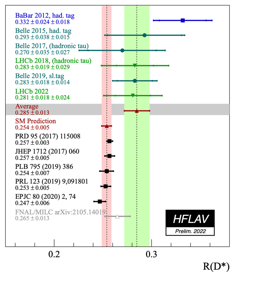
The LHCb collaboration has previously reported results of two independent measurements of R(D*) using purely leptonic τ decays τ–→μ–ντνμ (marked “LHCb15” in the images above to the left) and the hadronic decay channel τ–→π–π+π–(π0)ν (marked “LHCb18”). These measurements used RUN 1 data recorded during 2011-2012. Today’s measurements extended the purely leptonic “LHCb15” measurement from a 1D band to a 2D ellipse by measuring both R(D) and R(D*) simultaneously. For this purpose LHCb physicists had to face the challenge to distinguish between beauty particle decays with D mesons from those with D* mesons in the enviroment of a hadron collider. The combined result provides significantly improved sensitivity to the structure of a possible lepton universality breaking process originating from physics beyond SM.
The images above show a comparison of measurements from different experiments and their averages, as well as different theoretical calculations combined in the SM prediction, separately for R(D) and R(D*). The R(D) and R(D*) combinations exceed the SM prediction by 2.16σ and 2.26σ, respectively.
Read more in the seminar presentation and in the forthcoming paper.

